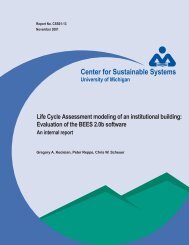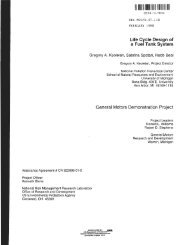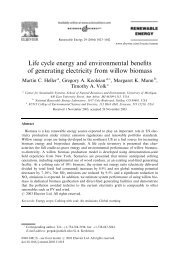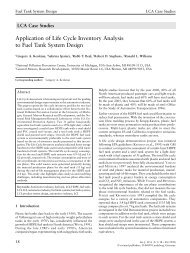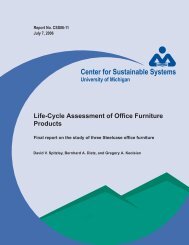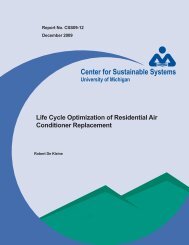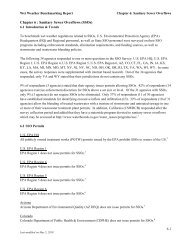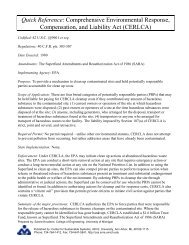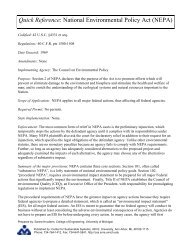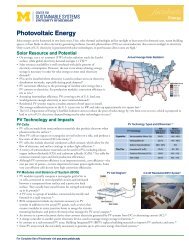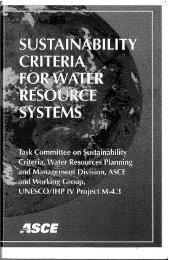A Life Cycle Assessment of the PureCell Stationary Fuel Cell System ...
A Life Cycle Assessment of the PureCell Stationary Fuel Cell System ...
A Life Cycle Assessment of the PureCell Stationary Fuel Cell System ...
- No tags were found...
You also want an ePaper? Increase the reach of your titles
YUMPU automatically turns print PDFs into web optimized ePapers that Google loves.
Executive Summary<br />
The <strong>Pure<strong>Cell</strong></strong> Model 200 Power Solution (formerly <strong>the</strong> PC25) is a stationary power<br />
system manufactured by UTC Power. It uses a 200 kW phosphoric acid fuel cell with a<br />
lifetime <strong>of</strong> 85,000 hours and it has an internal natural gas steam reforming system. The<br />
<strong>Pure<strong>Cell</strong></strong> system can operate in both grid-connected and grid-independent mode and it<br />
also provides <strong>the</strong> option <strong>of</strong> heat recovery. When it functions as a combined heat and<br />
power (CHP) system, efficiency <strong>of</strong> 80% is achieved. Since 1991, more than 275<br />
<strong>Pure<strong>Cell</strong></strong> power systems have been installed at various locations around <strong>the</strong> world.<br />
UTC Power is currently redesigning <strong>the</strong> system and would value having a life cycle<br />
assessment (LCA) to highlight opportunities for improvement <strong>of</strong> its environmental<br />
performance. LCA can clarify which stages in <strong>the</strong> product life cycle and which elements<br />
<strong>of</strong> <strong>the</strong> product cause <strong>the</strong> most environmental pressure. Product development and<br />
improvement is <strong>the</strong>refore one <strong>of</strong> its direct applications.<br />
The LCA results show that <strong>the</strong> use phase has by far <strong>the</strong> biggest environmental impact.<br />
The input <strong>of</strong> natural gas in <strong>the</strong> steam reforming process and <strong>the</strong> CO 2 emissions caused by<br />
this process are <strong>the</strong> main contributors to <strong>the</strong> use phase impact. Maximizing <strong>the</strong> hydrogen<br />
output <strong>of</strong> <strong>the</strong> steam reforming process and increasing <strong>the</strong> efficiency <strong>of</strong> <strong>the</strong><br />
electrochemical reaction in <strong>the</strong> fuel cell stack are <strong>the</strong>refore <strong>the</strong> main opportunities to<br />
improve <strong>the</strong> environmental performance <strong>of</strong> <strong>the</strong> <strong>Pure<strong>Cell</strong></strong> system. LCA results for a<br />
separate analysis <strong>of</strong> <strong>the</strong> manufacturing phase show that <strong>the</strong> fuel cell stack is responsible<br />
for almost half <strong>of</strong> <strong>the</strong> environmental impact <strong>of</strong> <strong>the</strong> manufacturing phase. The main cause<br />
is <strong>the</strong> high amount <strong>of</strong> energy used in <strong>the</strong> fuel cell stack manufacturing process. The<br />
biggest impacts per material in <strong>the</strong> manufacturing phase are caused by platinum used in<br />
<strong>the</strong> fuel cell stack, copper used in <strong>the</strong> power conditioning and control devices, and<br />
stainless steel 304 used for manifold applications. In <strong>the</strong> case <strong>of</strong> platinum especially it is<br />
beneficial to pursue a high recycling rate, since <strong>the</strong> environmental impact <strong>of</strong> recycled<br />
platinum is much smaller than that <strong>of</strong> raw platinum. The end-<strong>of</strong>-life phase has a small<br />
environmental impact compared to <strong>the</strong> use and manufacturing phases.<br />
This report also includes an analysis <strong>of</strong> two scenarios as opportunities for environmental<br />
improvement <strong>of</strong> <strong>the</strong> <strong>Pure<strong>Cell</strong></strong> system. One scenario analyzes <strong>the</strong> effect <strong>of</strong> using<br />
renewable hydrogen from wind energy instead <strong>of</strong> using hydrogen from natural gas steam<br />
reforming. The environmental impact is highly dependent on hydrogen transport from<br />
<strong>the</strong> wind turbine site to <strong>the</strong> <strong>Pure<strong>Cell</strong></strong> system site. However, if a transport distance <strong>of</strong><br />
100 miles is assumed, a decrease in <strong>the</strong> total <strong>Pure<strong>Cell</strong></strong> system life cycle environmental<br />
impact by a factor 7 is reached. The second scenario analyzes an alternative end-<strong>of</strong>-life<br />
treatment including reuse <strong>of</strong> <strong>Pure<strong>Cell</strong></strong> system components and maximizing platinum<br />
recycling. Component reuse impacts both <strong>the</strong> end-<strong>of</strong>-life phase (less output to waste<br />
management) and <strong>the</strong> manufacturing phase (less input <strong>of</strong> materials and energy) and<br />
shows a 16% decrease in <strong>the</strong> aggregated environmental impact <strong>of</strong> <strong>the</strong> manufacturing and<br />
end-<strong>of</strong>-life phase. The use phase impact is not taken into account here because <strong>the</strong><br />
alternative end-<strong>of</strong>-life scenario aims only at reducing <strong>the</strong> environmental impact <strong>of</strong> <strong>the</strong><br />
manufacturing and end-<strong>of</strong>-life phase.



